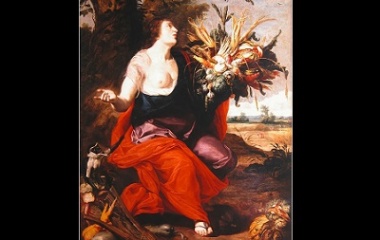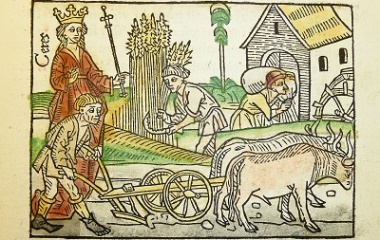- Pronunciation: Seh-reez
- Origin: Roman
- Parents: Saturn and Ops
- Other Names: Demeter (Greek)
- Powers: Controls fertility
The story of agriculture is essentially the story of civilization. When our ancestors finally stopped chasing food from one end of the world to the other and settled down to start growing their own food, it made everything that’s great about modern life possible.
Farming is a pretty complicated job, even these days with all the advantages of modern science and technology. So, you can imagine that ancient people could have no real idea of why their crops sometimes failed. Surely there must have been someone or something controlling the fortunes of the harvest? Well, for ancient Romans, that “someone” was Ceres, the goddess of agriculture.
Who Is Ceres?
When we say that Ceres is the goddess of agriculture, that doesn’t mean that she is the only one. In fact, many different gods and goddesses in the ancient Roman religion were linked to various aspects of agriculture. This goddess is, however, the only one to belong to the Dei Consentes. These are the 12 main gods and goddesses of Rome. Think of them as the A-Team or the Avengers of the ancient Roman religion, and you’ll have a clear idea of Ceres’ standing.
Ceres is a goddess of the common people; she doesn’t just govern over agriculture, but also over fertility in general. Much of what Ceres is responsible for concerns the daily lives of ordinary people, such as getting married and having children. She is officially the custodian of marriage laws, and violating those laws is therefore an affront to her.
The goddess Ceres is (as is the case with many Roman gods) an imported deity from the Greeks. Her counterpart on the Greek side of things is Demeter, and the mythologies of these two goddesses are basically impossible to tell apart, except for the different names the Romans used for everyone.
Appearance
Ceres is depicted as a human woman wearing robes. She is not shown as being young and beautiful, but rather handsome and motherly. She is almost always holding a sheath of grain and sometimes has a breast bared as a symbol of motherhood.
Family
Ceres is the daughter of the gods Saturn and Ops. Saturn is god of, well, many things. Among others, he is the god of plenty, wealth, time and agriculture. Ops too is a goddess of agriculture and fertility, so clearly Ceres continued the family tradition.
Family tradition was also on the agenda apparently, when she had a daughter with her brother Jupiter. For gods of the ancient world, family relationships never stood in the way of marriage.
That daughter’s name is Proserpine, and she is the only child of Ceres, unless of course you choose to believe some accounts that say Ceres is also the mother of Liber and Libera, who are both fertility gods. Whether she is in fact their mother is, however, not clear. She has three proper siblings besides Jupiter in the form of Vesta, Neptune and Pluto.
History
Ceres’ lineage is clear as the daughter of Saturn and Ops, but of course since she is essentially a renamed Demeter, the stories from Greek mythology all also apply.
As goddess of agriculture, many agricultural blessings are attributed to her. For example, the discovery of spelt wheat is said to have happened thanks to the goddess. Similarly, figuring out how to use oxen to plow fields and the actual plowing itself were her inventions. These were gifts that she gave to mankind in the same way that Prometheus gave humanity fire.
The most famous story that Ceres features in also involves her daughter, Proserpina. This is the same story that features Demeter, Persephone and Hades in Greek mythology.
Pluto (Hades) sees Proserpina (Persephone) out and about and takes a liking to her. Now, remember that Pluto is Ceres’ full brother, which makes Proserpina his niece. In some accounts, Pluto falls in love with her because of Cupid’s arrow, which explains why he then kidnaps his niece and takes her down to the underworld.
Ceres frantically searches for her daughter and forgets all about making the world fertile and nutritious. People begin to suffer, and Jupiter sends a message to his brother Pluto asking him to let Proserpina go. Pluto does this, but not before making Proserpina eat six underworld pomegranate seeds.
This forces Proserpina to spend six months a year with her mother, and six with her husband in the underworld. When Proserpina is away, Ceres sulks, which is why we have winter and autumn for six months of the year. When her daughter comes back, Ceres gives us spring and summer.
Origins
Since she is essentially the Greek goddess Demeter, this goddess shares the same origin tale. Demeter is one of the oldest Greek goddesses and is a daughter of primordial gods. In the Roman family tree of gods, she is in the sixth-generation following the very first and most ancient gods. In the Greek tradition, these were referred to as Titans.
Modern Influence
Ceres has stayed with us in modern times in ways that may be surprising. She has appeared on bank notes from the American Civil War, and has adorned the official artwork of government buildings.
We call grain-based breakfast food “cereals” because Ceres is the goddess of the harvest. In addition, one of the dwarf planets in the Solar System is named after her.
It seems that even now, when we know when it will rain or exactly what our crops need in order to grow bigger and stronger than ever, we still spare a thought for Ceres, who for so long ruled over the fates of the common people.










